
Roanoke College is a private liberal arts college in Salem, Virginia. It has approximately 2,000 students who represent approximately 40 states and 30 countries. The college offers 35 majors, 57 minors and concentrations, and pre-professional programs. Roanoke awards bachelor's degrees in arts, science, and business administration and is one of 280 colleges with a chapter of the Phi Beta Kappa honor society.

Georgetown is a historic neighborhood and commercial district in Northwest Washington, D.C., situated along the Potomac River. Founded in 1751 as part of the colonial-era Province of Maryland, Georgetown predated the establishment of Washington, D.C. by 40 years. Georgetown was an independent municipality until 1871 when the United States Congress created a new consolidated government for the entire District of Columbia. A separate act, passed in 1895, repealed Georgetown's remaining local ordinances and renamed Georgetown's streets to conform with those in Washington, D.C..

Georgetown College is a private Christian liberal arts college in Georgetown, Kentucky. Chartered in 1829, Georgetown was the first Baptist college west of the Appalachian Mountains.

The Demosthenian Literary Society is a literary society focused on extemporaneous debate at the University of Georgia in Athens, Georgia. It is among the oldest literary societies in the English-speaking world and was founded on February 19, 1803 by the first graduating class of the University's Franklin College. The object of the Society is "to promote the cause of science and truth by the cultivation of oratory and the art of debate at weekly meetings." It is named after the Greek orator Demosthenes.
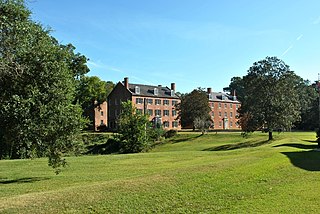
Jefferson College, in Washington, Mississippi, at 16 Old North Street. Named in honor of Thomas Jefferson, the college was chartered in 1802, but did not begin operation until 1811. Jefferson College was founded as an all-male college but operated primarily as a college-preparatory school, and later became a military boarding school, which it remained for most of its history.
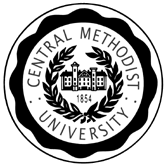
Central Methodist University is a private university in Fayette, Missouri. CMU is accredited to offer master's, bachelors, and associate degrees. The school is affiliated with the United Methodist Church.

Healy Hall is a National Historic Landmark and the flagship building of the main campus of Georgetown University in Washington, D.C., United States. Constructed between 1877 and 1879, the hall was designed by Paul J. Pelz and John L. Smithmeyer, both of whom also designed the Thomas Jefferson Building of the Library of Congress. The structure is named after Patrick Francis Healy, who was the President of Georgetown University at the time.
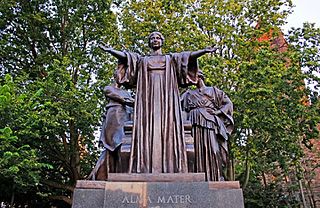
The University of Illinois Urbana-Champaign is an academic research institution that is the flagship campus of the University of Illinois System. Since its founding in 1867, it has resided and expanded between the twin cities of Champaign and Urbana in the State of Illinois. Some portions are in Urbana Township.
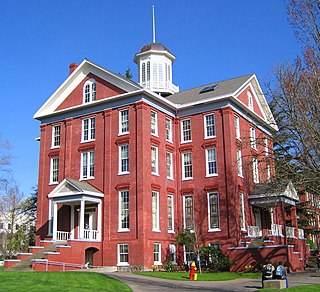
Waller Hall is a building on the campus of Willamette University in Salem, Oregon, in the United States. Opened in 1867 as University Hall, it is the oldest higher-education building west of the Mississippi River still in use, currently housing the university's administrative offices.

Pioneer Hall is the oldest building at Linfield College in McMinnville, Oregon, United States. Opened in 1883, the four-story Italianate structure formerly housed the entire school. Constructed of red bricks and topped with a belfry, the structure was added to the National Register of Historic Places in 1978 as Pioneer Hall, Linfield College. Part of the hall serves as residences and part as classrooms.
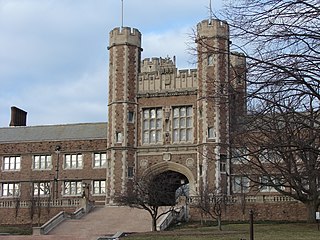
The Washington University Hilltop Campus Historic District was the site of the 1904 Louisiana Purchase Exposition and the 1904 Summer Olympics. Many of the exposition buildings were temporary in nature, but a number of permanent structures were built and are used by Washington University, which calls this area the Danforth Campus. The district includes more than fifty structures, of which twenty are in the Collegiate Gothic style.

Giddings Hall, originally called Recitation Hall, is a Greek Revival building located on the campus of Georgetown College in Scott County, Kentucky. Georgetown was the first Baptist college founded west of the Allegheny Mountains, and Giddings Hall was the first permanent structure constructed after the college was formed. The building is named after Rockwood Giddings, the third president of the school. The property was added to the U.S. National Register of Historic Places on February 6, 1973.

The Gorgas–Manly Historic District is a historic district that includes 12 acres (4.9 ha) and eight buildings on the campus of the University of Alabama in Tuscaloosa, Alabama. The buildings represent the university campus as it existed from the establishment of the institution through to the late 19th century. Two buildings included in the district, Gorgas House and the Little Round House, are among only seven structures to have survived the burning of the campus by the Union Army, under the command of Brigadier General John T. Croxton, on April 4, 1865. The other survivors were the President's Mansion and the Old Observatory, plus a few faculty residences.

The History of Louisiana Tech University began when the Industrial Institute and College of Louisiana was founded in Ruston, Louisiana in 1894. The institute was founded to develop an industrial economy in the state of Louisiana. Four years later, the school was renamed the Louisiana Industrial Institute when Louisiana adopted the Constitution of 1898. When the Constitution of 1921 was passed, the school changed its name again to Louisiana Polytechnic Institute to reflect the school's evolution from a trade school into a larger and broader technical institute. Although the university was informally called Louisiana Tech for about five decades after the 1921 name change, it was not until 1970 when Louisiana Polytechnic Institute officially changed its name to Louisiana Tech University. Over the course of its history, the school grew from a small industrial institute with one building to a university with five colleges and an enrollment of around 11,800 students.

Starkweather Hall, also known as Starkweather Religious Center, is a religious and educational building located at 901 West Forest Avenue in Ypsilanti, Michigan, on the campus of Eastern Michigan University. It was designated a Michigan State Historic Site in 1972 and listed on the National Register of Historic Places in 1977. It is also part of the Eastern Michigan University Historic District and is the oldest building on EMU's campus.

Alexander Johnston Hall is a historic building located on the corner of Somerset Street and College Avenue, New Brunswick in Middlesex County, New Jersey and is the second oldest building on the campus of Rutgers University. It was built in 1830 to handle the expansion of the Rutgers Preparatory School and the two literary societies, Philoclean and Peithessophian. The building, described using its historic name, Rutgers Preparatory School, was added to the National Register of Historic Places on July 18, 1975 for its significance in architecture and education.

Goodnow Hall is a historic structure located on the Grinnell College campus in Grinnell, Iowa, United States. A tornado struck the college's campus in 1882, and this was one of four buildings that replaced the destroyed buildings. It is now the oldest building on campus. The other three are no longer extant. The building is named for Edward A. Goodnow, who was a well-known abolitionist and reformer who promoted public education for women. He donated $10,000 to the college to construct this building, which was the library until 1905. It was converted into office space and classrooms after that time. It was renovated again in 1995, and it housed the Department of Anthropology and later the Department of Gender, Women's, and Sexuality Studies. The three-story building was designed by Worcester, Massachusetts architect Stephen C. Earle in the Richardsonian Romanesque style. It features a tower on the northwest corner of the structure that was originally capped by a domed astronomical observatory. The exterior is composed of rusticated Sioux Falls granite. The building was listed on the National Register of Historic Places in 1979.

The Little Campus is a historic district and part of the University of Texas at Austin campus in Austin, Texas. Originally built in 1856 as the Texas Asylum for the Blind, the complex was used for a variety of purposes through the late nineteenth and early twentieth centuries. It was acquired by the University of Texas after World War I and listed on the National Register of Historic Places in 1974.

The Richland Historic District is a commercial and residential historic district located in the center of Richland, Michigan, containing structures near the intersection of 32nd Street, D Avenue, and Gull Road. The district was listed on the National Register of Historic Places in 1997.





















